|
|
Expedition
Expedition | People
|
Log - July-26-2003
by Gerhard Behrens and Robert McCarthy
Previous | Next
| Water testing begins |
| While IÕm waiting for the cups to return, my thoughts are in France, this being the penultimate day of this yearÕs Tour de France bicycle race. For those who do not know, American Lance Armstrong is trying for a record tying 5th consecutive win in arguably the toughest human sporting event, the Tour de France. Each year, riders struggle to make it over the high passes in the Alps and Pyrenees, and battle elbow to elbow in all-out sprints for the dream of a lifetime, to win a single stage in this revered event. To win the entire race is the dream of only a select few. This year, Lance has a formidable opponent in Jan Ullrich, and this yearÕs winner, even though there is one more stage tomorrow, will be determined today. It is a time trial race, where each rider goes off on the same course in 2 minute intervals starting with the last place rider. The final racer to leave is the current rider with the lowest accumulated time over this three week race. This year, Lance only has a 67 second lead over second place rider, Jan Ullrich. I hope that is enough---GO LANCE! |
| The Healy has a couple of "Life-Cycle" stationary bicycles on board, and this morning I chose the ŌWATTĶ workout. A watt is a Joule per second, which is a measure of power. Power is the amount of energy per unit of time. While using the "Life-Cycles", you can choose the power level, and the machine knows to adjust the resistance of the pedals based on the number of revolutions per minute (rpm) of your feet. So if the cadence drops (meaning that youÕre pedaling slower), the resistance goes up, and conversely if you pedal faster, the resistance goes down. This is opposite to what happens while on the road, since if you pedal faster, your speed goes up, and the wind drag increases as the speed squared. Anyway, after cycling for 1 hour at a moderate setting of 200 watts, I set the wattage to 350 watts, and barely kept my cadence at 100 rpmÕs for just 1 minute. The best cyclists in the world, Lance and Jan, can maintain approximately 500 watts for an entire hour. WOW, they are incredible. |
| If we now assume some simplifying assumptions, letÕs try to determine the force applied to each pedal to maintain my 350 watts, at 100 revolutions per minute for an entire minute. LetÕs assume that the crank arm of the ŌLife-CycleĶ is 175 mm, so that each foot pushes down 350 mm (0.35 meters), that each foot is independent of the other foot, meaning that weÕre not lifting up on the pedals or for that matter have the added resistance to raise the other foot while pushing down, and we will ignore internal resistance of the pedal arms. Since power is energy per time, and I maintained that power for 60 seconds, then the total energy is just 21,000 Joules (350 watts times 60 seconds). This energy is supplied by my work on those pedals, and work is a force times a distance. So dividing 21,000 Joules by the total distance of 70 meters (0.35 meters times my 100 rpmÕs times 2 for each foot) gives us 300 Newtons, or 67 lbs of force on each pedal 100 times a minute. |
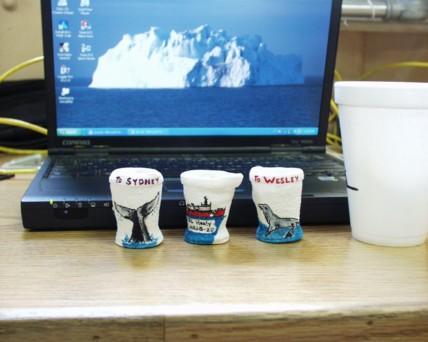 |
Now for the cups that returned after a 2430 meter descent to the ocean bottom. The cups were placed in nylon stockings, and each cup was separated from the next by either a rubber band or a knot around the stocking. These stockings were then placed in diving bags that allowed water to enter. Since there were a large number of cups, the condition upon return was pot luck. Some returned crumpled, folded, or in various states of compaction. |
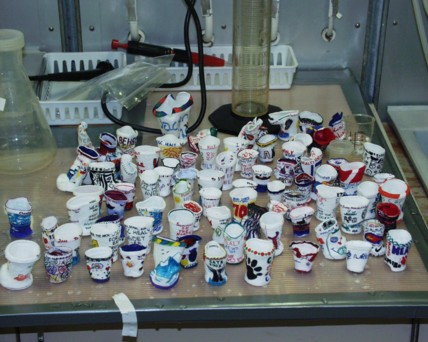 |
| I was lucky that mine were OK. The size reduction was about 2.25 times, so the volume reduction was about 11 times less. This was also tested by counting how many little cups were needed to fill the big cup. ItÕs amazing what 242 atmospheres can do to objects, and these considerations must be accounted for when engineers design oceanographic equipment, such as acoustic releases that will be discussed tomorrow. |
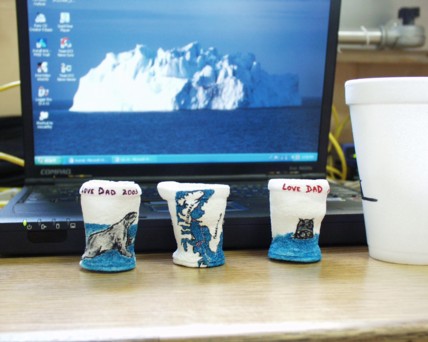 |
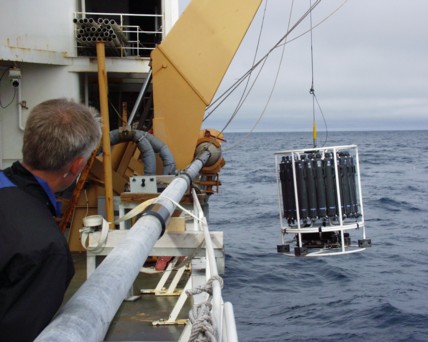 |
For lots of scientists on this cruise this day began at midnight. The first cage of bottles was dropped into Baffin Bay a little before midnight. It was lowered on a wire to 2,400 meters. That is two and a quarter miles down. Or, think of it as 24 soccer fields end to end. When it was brought back up, an electric signal told a certain bottle to close tight and trap seawater at that spot. Each plastic bottle can hold 12 liters of water (about 3 gallons). The scientists had to decide where they wanted water samples. For example, they might have water from 2,000 meters, 1,500 meters, or 1,000 meters. They can get up to 24 water samples from different depths. |
| When the samples arrive on deck, everyone wants to begin testing. It is VERY important that water samples are labeled and handled carefully. A glass bottle has to be rinsed out three times, and then a sample is squirted into a small bottle. It looks a lot like milking a cow, but instead of getting milk from an animal, the workers take seawater from big plastic bottles. Everyone is interested in getting started on lab tests. Some people stayed up most of the night working on their samples. |
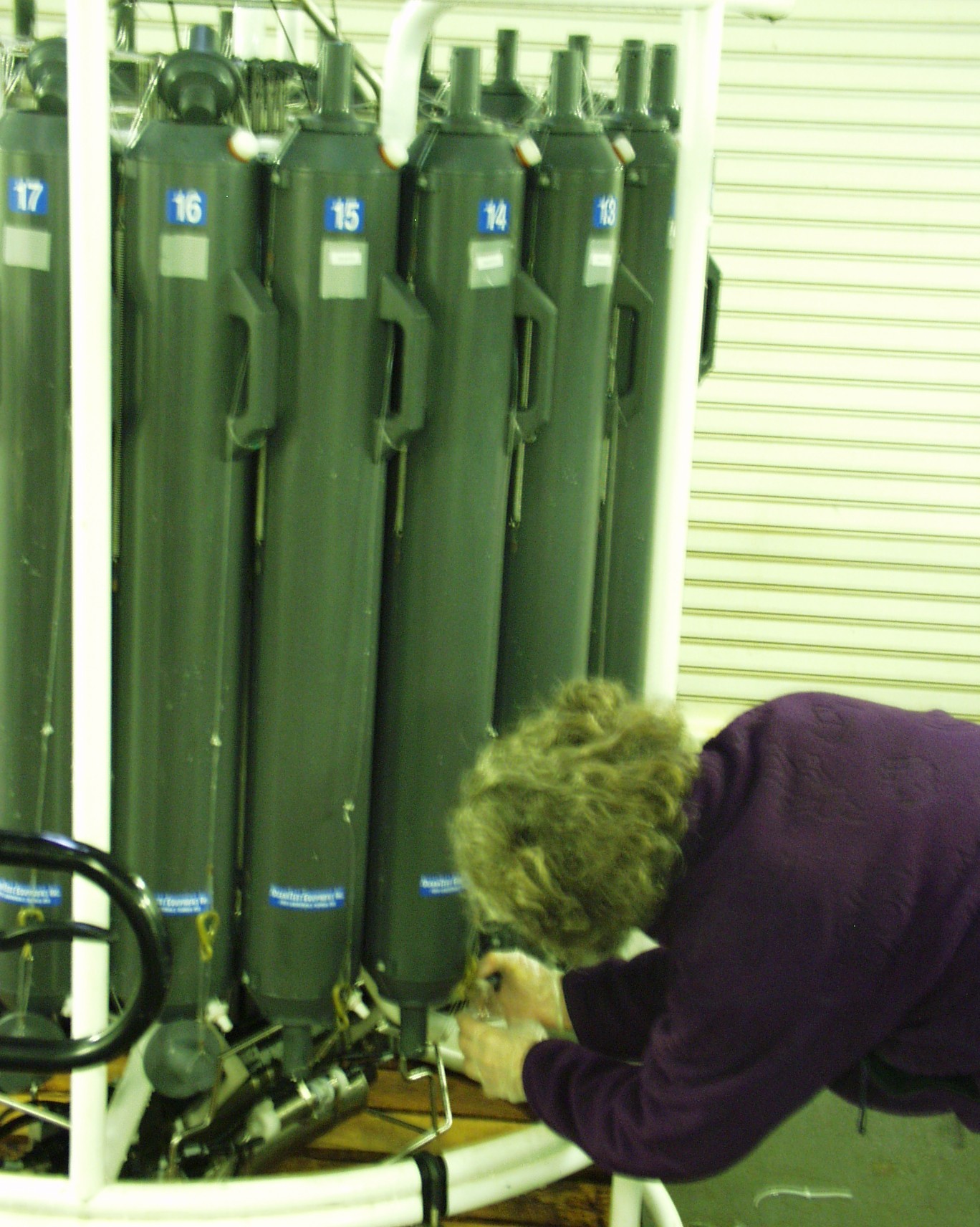 |
| Now that we are in Baffin Bay, where lots of testing will happen, the science crew begins a weird schedule. We collect water or drop in scientific equipment whenever we get to an important spot. Work could start around midnight as it did yesterday, or it could happen at 2:00pm or 2:00 am. Everyone has to be ready to work at any time of day or night.
|
| Which reminds me. Yesterday (Friday to Saturday) was our first night with no sunset. As the sun hit the horizon, it just cruised along a bit and then started a slow rise for another 24-hour period of light. We wonÕt see nighttime until August 16th, the last day on the cruise. |
| Yesterday I mentioned the job is dangerous and difficult, and I gave reasons for both. I found out four more reasons why doing this kind of science work is so hard. First, we are always getting closer to the North Pole, which messes up a compass, even one in a computer. That makes it harder to find the exact spot you hope to test. Second, Baffin Bay has strong currents, which makes it hard to keep the ship from moving while testing is going on. Next, Baffin Bay has a very bumpy bottom with its own hills and valleys. That makes it hard to find good spots for the tests. Finally, There can be lots of icebergs, and in the very far north, there can still be sea ice. Just think, ŌTitanic,Ķ and you get the picture why icebergs can make a science trip harder. |
| Right now, we are steaming to the next ŌstationĶ where we will drop the bottles and do the same thing all over again. The more samples we can get mean the more information we can get. The more information we get means the more we can understand about the waters and currents of this area. |
| On a goofy note, we received an order that all bathrooms were closed. This happens whenever someone puts the wrong thing down the toilet. We are supposed to use toilet paper from the ship and NOTHING else. Things as small as dental floss, tissue paper, or paper towel can block the system. Thankfully, the problem was solved in about an hour. Another goofy thing: If one engine goes out, there is a second one. If one fresh water evaporator goes out, there is a second one. If one steering system goes out, there is a second one. But, if the bathroom system goes out, there is not a second chance. |
| Check out the fun facts for some words scientists and crew use on the ship. |
|
